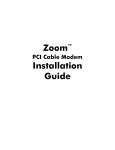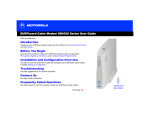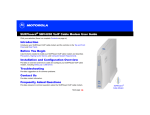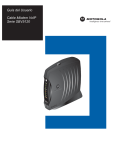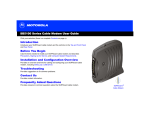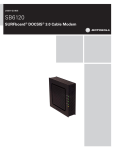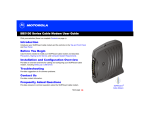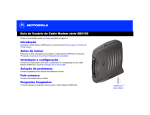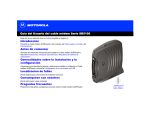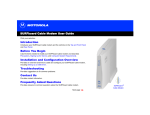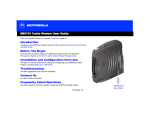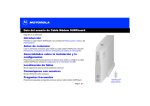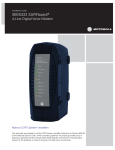Download Motorola Communications Gateway Network Card User Manual
Transcript
Title Communications Gateway User Guide Click your selection: Introduction Introduces your Motorola Communications Gateway and the Top and Front Panel, Connector Panel, and Battery Compartment. Before You Begin Lists the items needed to install your Motorola Communications Gateway and describes Precautions, Signing Up for Service, and Computer System Requirements. Installation and Configuration Overview Provides an overview and links to cable and configure your Motorola Communications Gateway, including Setting Up a USB Driver. Troubleshooting Provides suggestions to fix common problems. Contact Us Provides contact information. Frequently Asked Questions Provides answers to common questions about the Motorola Communications Gateway. Next page WARNING: TO PREVENT FIRE OR SHOCK HAZARD, DO NOT EXPOSE THIS APPLIANCE TO RAIN OR MOISTURE. THE APPARATUS SHALL NOT BE EXPOSED TO DRIPPING OR SPLASHING AND NO OBJECTS FILLED WITH LIQUIDS, SUCH AS VASES, SHALL BE PLACED ON THE APPARATUS. CAUTION: TO ENSURE REGULATORY AND SAFETY COMPLIANCE, USE ONLY THE PROVIDED POWER CABLES. TO PREVENT ELECTRICAL SHOCK, DO NOT USE THIS PLUG WITH AN EXTENSION CORD, RECEPTACLE, OR OTHER OUTLET UNLESS THE BLADES CAN BE FULLY INSERTED TO PREVENT BLADE EXPOSURE. CAUTION: DO NOT PERFORM ANY SERVICING OTHER THAN THAT CONTAINED IN THE INSTALLATION AND TROUBLESHOOTING INSTRUCTIONS UNLESS YOU ARE QUALIFIED TO DO SO. REFER ALL SERVICING TO QUALIFIED SERVICE PERSONNEL. CAUTION: DO NOT SHORT CIRCUIT THE BATTERY TERMINALS. DO NOT CHARGE THE BATTERY UNDER AIRTIGHT CONDITIONS. DO NOT DISASSEMBLE, DROP, OR MECHANICALLY SHOCK THE BATTERY. DO NOT EXPOSE THE BATTERY TO FLAME OR SPARK. KEEP THE BATTERY OUT OF THE REACH OF CHILDREN. It is recommended that the customer install an AC surge arrestor in the AC outlet to which this device is connected. This is to avoid damaging the equipment by local lightning strikes and other electrical surges. Different types of cord sets may be used for connections to the main supply circuit. Use only a main line cord that complies with all applicable product safety requirements of the country of use. This product was qualified under test conditions that included the use of the supplied cable between system components. To be in compliance with regulations, the user must use this cable and install it properly. Home Print X Exit ii Communications Gateway User Guide This product is provided with a separate Regulatory and Safety Information and Software License and Warranty Information card. If one is not provided with this product, please ask your service provider or point-of-purchase representative, as the case may be. ■ THIS PRODUCT IS IN COMPLIANCE WITH ONE OR MORE OF THE STANDARDS LISTED ON THE REGULATORY AND SAFETY INFORMATION CARD. NOT ALL STANDARDS APPLY TO ALL MODELS. ■ NO WARRANTIES OF ANY KIND ARE PROVIDED BY MOTOROLA WITH RESPECT TO THIS PRODUCT, EXCEPT AS STATED ON THE SOFTWARE LICENSE AND WARRANTY INFORMATION CARD. MOTOROLA’S WARRANTIES DO NOT APPLY TO PRODUCT THAT HAS BEEN REFURBISHED OR REISSUED BY YOUR SERVICE PROVIDER. Copyright © March 2002 by Motorola, Inc. All rights reserved. No part of this publication may be reproduced in any form or by any means or used to make any derivative work (such as translation, transformation or adaptation) without written permission from Motorola, Inc. Motorola reserves the right to revise this publication and to make changes in content from time to time without obligation on the part of Motorola to provide notification of such revision or change. Motorola provides this guide without warranty of any kind, either implied or expressed, including, but not limited to, the implied warranties of merchantability and fitness for a particular purpose. Motorola may make improvements or changes in the product(s) described in this manual at any time. MOTOROLA and the Stylized M Logo are registered in the US Patent & Trademark Office. Microsoft and Windows are registered trademarks and Windows Me and Windows XP are trademarks of Microsoft Corporation. Macintosh is a registered trademark of Apple Computer, Inc. Netscape and Navigator are registered trademarks of Netscape Communications Corporation. UNIX is a registered trademark of the Open Group in the United States and other countries. All other product or service names are the property of their respective owners. © Motorola, Inc. March 2002. Home Print X Exit iii Communications Gateway User Guide Contents Introduction ............................................................................................................................................ 1 Telephone Communications .............................................................................................................................. 1 High-Speed Internet Access .............................................................................................................................. 2 Top and Front Panel .............................................................................................................................. 3 Connector Panel .................................................................................................................................... 5 Battery Compartment ............................................................................................................................ 6 Before You Begin ................................................................................................................................... 7 Precautions ............................................................................................................................................ 8 Signing Up for Service ........................................................................................................................ 10 Cable Data Service .......................................................................................................................................... 10 Telephone Service ........................................................................................................................................... 10 Computer System Requirements ....................................................................................................... 11 Ethernet Card .................................................................................................................................................. 11 USB Connection .............................................................................................................................................. 11 Installation and Configuration Overview ........................................................................................... 12 Cabling and Startup for a Single User ............................................................................................... 13 Setting Up a USB Driver ...................................................................................................................... 21 Setting Up a USB Driver in Windows 98 SE ...................................................................................... 22 Setting Up a USB Driver in Windows 2000 ........................................................................................ 26 Setting Up a USB Driver in Windows Me ........................................................................................... 30 Home Print X Exit iv Communications Gateway User Guide Setting Up a USB Driver in Windows XP ........................................................................................... 31 Configuring TCP/IP .............................................................................................................................. 32 Configuring TCP/IP in Windows 95, 98, or Me .................................................................................. 33 Configuring TCP/IP in Windows 2000 or XP ..................................................................................... 36 Verifying the IP Address in Windows 95, 98, or Me ......................................................................... 40 Verifying the IP Address in Windows 2000 or XP ............................................................................ 41 Cabling for Multiple Users .................................................................................................................. 43 Ethernet and USB ............................................................................................................................................ 43 Ethernet ........................................................................................................................................................... 44 Replacing the Battery .......................................................................................................................... 45 Wall Mounting ...................................................................................................................................... 50 Troubleshooting .................................................................................................................................. 54 Lights and Error Conditions ............................................................................................................................. 56 Removing the USB Driver from Windows 98 or Me ........................................................................................ 57 Removing the USB Driver from Windows 2000 or XP ..................................................................................... 61 Contact Us ............................................................................................................................................ 67 Frequently Asked Questions .............................................................................................................. 68 Glossary ............................................................................................................................................... 71 Software License ................................................................................................................................. 75 Home Print X Exit v Communications Gateway User Guide Introduction Before You Begin Installation & Configuration Troubleshooting FAQ Glossary License Introduction IP telephony converges with cable data service in one convenient package! You can place your Communications Gateway on your desktop or mount the unit as described in “Wall Mounting” on page 50. Congratulations, you have a new Motorola® Communications Gateway! It provides the following converged services over a single coaxial cable (coax) network: ■ Up to two telephone lines for voice and/or fax communication ■ High-speed access to the Internet and other online services Telephone Communications You can connect up to two phone lines using your Motorola Communications Gateway. The Communications Gateway supports voice over Internet Protocol (VoIP) to provide: ■ Connections to two standard telephone lines ■ Standard features such as caller ID, call waiting, and call forwarding ■ Software upgrades over the network to provide new or improved services ■ Battery back-up during power interruptions through a built-in uninterruptible power supply (UPS) Just pick up your phone and talk! Home Print X Exit 1 Communications Gateway User Guide Introduction Before You Begin Installation & Configuration Troubleshooting FAQ Glossary License Introduction, continued High-Speed Internet Access Easier! Unlike dial-up modems or ISDN, you’re always on, always connected. Faster! Your Communications Gateway is up to 100 times faster than a dial-up modem. It can provide data transfer rates of up to 10 Mbps upstream and 50 Mbps downstream. Because many network and other factors can affect performance, the actual speed will vary. Better! Your Communications Gateway is made by the company with over 50 years of cable TV expertise. Home Print X Exit You can use your high-speed, upgradeable Communications Gateway to connect one or more computers in your home or business to the Internet. Your Communications Gateway transmits and receives computer data much faster than traditional dial-up or ISDN modems. Unlike a dial-up modem, your Communications Gateway is always online. Just open your browser and surf! You can connect: ■ A single computer equipped with a Universal Serial Bus (USB) port directly to the USB port on the Motorola Communications Gateway ■ A single computer equipped with an Ethernet adapter directly to the Ethernet port on the Motorola Communications Gateway ■ Two computers; one to the USB port and one to the Ethernet port ■ Up to 32 computers through a single Motorola Communications Gateway using an Ethernet hub 2 Communications Gateway User Guide Introduction Before You Begin Installation & Configuration Troubleshooting FAQ Glossary License Top and Front Panel For added security, you can press the Internet Security Lock button (1) to suspend your Internet connection. The Internet Security Lock symbol on the button lights yellow. Your computer cannot transmit or receive data. The Online light turns off until you press the Internet Security Lock button again. Regardless of the Internet Security Lock status, the Communications Gateway remains registered and telephone service continues. 1 Light 2 Description Power: Solid green when the AC power is on. Flashes green when the self test is in progress. ■ Off when the AC power is off and the battery is in use. This can be because the plug was disconnected, a power failure occurred, or some other problem. 3 Online: ■ Flashes green while the Communications Gateway downloads its configuration data. ■ Solid green when the configuration data is successfully downloaded. Activity — Flashes yellow when transmitting or receiving data. Ac 4 e ■ O nl in 6 5 4 3 2 tiv ity O nl in e A ct iv ity The lights provide information about power, communications, and errors: Home Print X Exit 3 Communications Gateway User Guide Introduction Before You Begin Installation & Configuration Troubleshooting FAQ Glossary License Top and Front Panel, continued 1 Light Description 5 Battery: Off when the AC power is on and the battery is not in use (the Communications Gateway is functioning normally) ■ Solid yellow when the battery is in use (there is no AC power) ■ Flashes yellow when the battery is low ■ Solid red when the battery is missing or the battery terminals are connected backwards ■ Flashes red when the battery has failed To replace the battery, follow the instructions in “Replacing the Battery” on page 45. O nl in e A ct iv ity ■ 6 5 4 3 2 6 Reserved for future use During normal operation: Home Print X Exit ■ The power and Online lights are on ■ The Activity light flashes when the Communications Gateway transfers data ■ The battery light is off 4 Communications Gateway User Guide Introduction Before You Begin Installation & Configuration Troubleshooting FAQ Glossary License Connector Panel The connector panel provides cabling connectors and Ethernet status lights. Item Description 1 The standard RJ-11 telephone ports provide connections for telephone lines 1 and 2 2 When this light is on (green), the Ethernet connection is available. It blinks when data is being transferred. The Ethernet port provides a connection to Ethernet equipped computers using a cable terminated with an RJ-45 connector. 3 1 2 3 4 5 6 7 8 9 4 This light is on (green) for a 100Base-T link and off for a 10Base-T link. 5 The USB port provides a connection to USB equipped computers. 6 The Coax port provides a connection to the coaxial cable (coax) outlet. 7 If you experience a problem, you can push this recessed button to reset the Communications Gateway (see “Troubleshooting” on page 54). Resetting may take 5 to 30 minutes because the Communications Gateway must find and lock on the appropriate communications channels. These labels provide the cable data and telephony MAC addresses. 8 and 9 Home Print X Exit 5 Communications Gateway User Guide Introduction Before You Begin Installation & Configuration Troubleshooting FAQ Glossary Battery Compartment For instructions to remove the battery compartment cover, see “Cabling and Startup for a Single User” on page 13. 3 1 Home 2 Print 4 5 X Exit 6 7 The battery compartment contains: Item Description 1 Power connector 2 Strain-relief posts for power cord 3 Positive battery wire (red) 5 Negative battery wire (black) 5 Battery snaps 6 Back-up battery 7 Battery hook 6 Communications Gateway User Guide License Introduction Before You Begin Installation & Configuration Troubleshooting FAQ Glossary License Before You Begin Before you begin the installation, check that you received the following items with your Motorola Communications Gateway: Item Description Power cord Connects to the AC electrical outlet 10/100Base-T Ethernet cable Connects to the Ethernet port USB cable Connects to the USB port Phone wire Connects a telephone line Motorola Communications Gateway CD-ROM Contains the User Guide, USB driver, and other items supporting your Communications Gateway You will need 75-ohm coaxial cable (coax) with F-type connectors to connect your Communications Gateway to the nearest cable outlet. If a TV is connected to the cable outlet, you may need a 5 to 900 MHz RF splitter to use both the TV and the Communications Gateway. Both the coaxial cable and the RF splitter are readily available at consumer electronic stores. Home Print X Exit 7 Communications Gateway User Guide Introduction Before You Begin Installation & Configuration Troubleshooting FAQ Glossary License Precautions To avoid damaging your Communications Gateway or computer with static electricity: Always make the wall connection first. Postpone Communications Gateway installation until there is no risk of thunderstorm or lightning activity in the area. To avoid damaging the Communications Gateway with static electricity: ■ Always first connect the coaxial cable to the grounded cable TV wall outlet. ■ Before you connect or disconnect the USB or Ethernet cable from your Communications Gateway or PC, always touch the coaxial cable connector on the Communications Gateway to release any static charges. To prevent overheating the Communications Gateway, do not block the ventilation holes. Do not open the Communications Gateway. Refer all service to your service provider. Wipe the Communications Gateway with a clean, dry cloth. Never use cleaning fluid or similar chemicals. Do not spray cleaners directly on the unit or use forced air to remove dust. Before you connect or disconnect the USB or Ethernet cable, always touch the coaxial cable connector on the Communications Gateway. Home Print X Exit 8 Communications Gateway User Guide Introduction Before You Begin Installation & Configuration Troubleshooting FAQ Glossary License Precautions, continued If you mount your Communications Gateway on the wall following the instructions in “Wall Mounting” on page 50, be sure that you: ■ Mount the Communications Gateway with the battery terminals facing up or sideways. To prevent possible leakage, do not mount the Communications Gateway with the battery terminals facing down. ■ Use the Wall Mounting Template on page 53 to position the mounts ■ Before drilling holes, check the structure for potential damage to water, gas, or electric lines. ■ Use M5 x 38 mm (#10-16 x 11/2 inch) wall mounts that can support at least 2.5 kg (5.5 lbs) and anchors if necessary You must comply with the following battery-related precautions: Home Print X Exit ■ Do not short circuit the battery terminals by simultaneously touching both terminals with a metal object. ■ Do not charge the battery under airtight conditions. ■ Do not disassemble, drop, or mechanically shock the battery. ■ Do not expose the battery to flame or spark. ■ Keep the battery out of the reach of children. 9 Communications Gateway User Guide Introduction Before You Begin Installation & Configuration Troubleshooting FAQ Glossary License Signing Up for Service To receive Internet access or telephone service, you must sign up with a cable service provider. To activate your service, call your local service provider. Cable Data Service P/N: 476203-001 Internet MAC Made in Taiwan, R.O.C. CM HFC MAC ID: ABCDEF012345 You should ask your service provider the following questions: CUSTOMER S/N: BCDEFGHJKLMNP ■ Do you have any special system requirements? ■ When can I begin to use my Communications Gateway? ■ Are there any files I need to download after I am connected? ■ Do I need a user name or password to access the Internet or use e-mail? S/N: PPPPMMYYJJJSSSSSCKAABBCCCC Telephone MAC There is a sticker with bar code labels next to the Connector Panel. To receive Internet access, you need to provide the MAC address marked CM HFC MAC ID to your service provider. MTA MAC ID: ABCDEF012345 Telephone Service There is a sticker with bar code labels next to the Connector Panel. To receive telephone service, you need to provide the MAC address marked MTA MAC ID to your service provider. Home Print X Exit 10 Communications Gateway User Guide Introduction Before You Begin Installation & Configuration Troubleshooting FAQ Glossary License Computer System Requirements You can use any web browser such as Microsoft® Internet Explorer or Netscape® Navigator® with your Motorola Communications Gateway. Your Motorola Communications Gateway is compatible with Microsoft Windows®, Macintosh®, and UNIX® computers. Ethernet Card You can use the Ethernet connection with any Windows, Macintosh, or UNIX computer equipped with a standard 10Base-T or 10/100Base-T Ethernet card. Windows 95, UNIX, or Macintosh computers must use the Ethernet connection. If you use an Ethernet card, it must be installed in your computer before you install the Communications Gateway. If it is not installed, follow the installation instructions provided with your Ethernet card. USB Connection You can use the USB connection with any PC running Windows 98 SE, Windows 2000, Windows Me™, or Windows XP™ that has a USB interface. The USB connection requires a special USB driver supplied on the Motorola Communications Gateway CD-ROM. You can upgrade the USB drivers from the Internet. For information, check our website http://www.motorola.com/broadband. Home Print X Exit 11 Communications Gateway User Guide Introduction Before You Begin Installation & Configuration Troubleshooting FAQ Glossary License Installation and Configuration Overview To install and configure your Motorola Communications Gateway, you need to: 1 Home Print X Exit Install the cables as described in one of: ■ “Cabling and Startup for a Single User” on page 13 ■ “Cabling for Multiple Users” on page 43 2 If you are using the USB Connection, set up the USB driver. Follow the instructions in “Setting Up a USB Driver” on page 21. Ethernet users can skip this step. 3 Configure TCP/IP following the instructions in “Configuring TCP/IP” on page 32 or the instructions in your Macintosh or UNIX user manual. 4 Verify the IP address following one of: ■ “Verifying the IP Address in Windows 95, 98, or Me” on page 40 ■ “Verifying the IP Address in Windows 2000 or XP” on page 41 ■ The instructions in your Macintosh or UNIX user manual 12 Communications Gateway User Guide Introduction Before You Begin Installation & Configuration Troubleshooting FAQ Glossary License Cabling and Startup for a Single User To cable outlet or splitter Allow 5 to 30 minutes to power up the first time because the Motorola Communications Gateway must find and lock on the appropriate channels for communications. 1 Be sure your computer is on and the Communications Gateway is unplugged. 2 Connect one end of the coaxial cable to the cable outlet or splitter. 3 Connect the other end of the coaxial cable to the Coax connector on the Communications Gateway. 4 Hand-tighten the connectors to avoid damaging them. 5 Insert the Motorola Communications Gateway CD-ROM into your CD-ROM drive. Coax connector Home Print X Exit 13 Communications Gateway User Guide Introduction Before You Begin Installation & Configuration Troubleshooting FAQ Glossary License Cabling and Startup for a Single User, continued 3 2 6 On the battery compartment cover, push in on the tabs, as shown by arrows 1 in the illustration at top left. 7 Carefully remove the battery compartment cover by lifting up about 2 to 3 cm (1 inch) and then pulling straight out. To avoid damaging the cover, be sure you rotate it only slightly (arrow 2) before pulling it out (arrow 3). For a description of the battery compartment, see “Battery Compartment” on page 6. 1 1 8 As shown at lower left, depress both battery snaps (arrows 1) while gently raising the positive end of the battery (arrow 2). 9 When the battery rotates past the snaps, slide the battery out as shown below. Be sure you do not damage the battery wires or terminals. Battery hook 2 1 1 Battery snaps Home Print X Exit 14 Communications Gateway User Guide Introduction Before You Begin Installation & Configuration Troubleshooting FAQ Glossary License Cabling and Startup for a Single User, continued 10 Plug the power cord into the Power connector on the Communications Gateway. 11 Wrap the power cord around the strain-relief posts, as shown at left. Do not plug the power cord into the AC wall outlet at this time. To power outlet Strain-relief posts Home Print X Exit 15 Communications Gateway User Guide Introduction Before You Begin Installation & Configuration Troubleshooting FAQ Glossary License Cabling and Startup for a Single User, continued For safety and to prevent damage to the equipment, the Communications Gateway is shipped with the battery wires disconnected. Do not short circuit the battery terminals by simultaneously touching both terminals with a metal object. 12 Connect the black negative battery wire to the black negative (-) terminal on the battery. 13 Connect the red positive battery wire to the red positive (+) terminal on the battery. After you connect the battery, the Communications Gateway begins drawing power but does not start. Home Print X Exit 16 Communications Gateway User Guide Introduction Before You Begin Installation & Configuration Troubleshooting FAQ Glossary License Cabling and Startup for a Single User, continued 14 On a slight angle, gently slide the top-right corner of the battery under the battery First, slide the battery under the hook hook as shown at left. While you rotate the battery into position, to avoid pinching the wires between the battery and the base, be sure the battery wires are not under the battery. Pinching the wires between the battery and the base: ■ May damage the wires ■ Will cause the battery to seat incorrectly 15 Rotate the battery into position under the battery snaps as shown by the arrow at left. When the battery is fully seated, the snaps engage the battery base. Then rotate the battery under the snaps Home Print X Exit 16 Carefully replace the battery compartment cover. Do not force the cover closed. If the battery compartment cover does not close easily, check that: ■ The power cord is positioned correctly in its opening ■ The battery is correctly seated (you performed steps 14 to 15 correctly) 17 Communications Gateway User Guide Introduction Before You Begin Installation & Configuration Troubleshooting FAQ Glossary License Cabling and Startup for a Single User, continued 17 Immediately plug the power cord into the electrical outlet. This turns your Motorola Communications Gateway on. You do not need to unplug it when not in use. 18 Check that the lights on the Communications Gateway cycle through this sequence: Home Print X Exit ■ Power flashes during the self-test and changes to solid green when the self-test is successfully complete. ■ Online flashes while the Communications Gateway downloads its configuration data and changes to solid green when the download is complete. 18 Communications Gateway User Guide Introduction Before You Begin Installation & Configuration Troubleshooting FAQ Glossary License Cabling and Startup for a Single User, continued Caution 19 To connect the telephone line(s), plug a telephone wire into one or both phone jacks. Do not connect both the Ethernet and USB cables to the same computer. P/N : 47 62 03 - 00 1 Caution If you connect to a wired telephone wall jack, be sure it is not connected to a traditional telephone (PSTN) service. M ad e i n T ai w an , R . O. C . CM H FC M AC ID : A B CDE F 01 23 45 CU S TOM E R S/ N : B CD EF G HJK L MN P S/N : PPP P MM Y Y JJ JS SSS S CK A ABB C CC C 20 To connect to the Internet, connect your computer to the Communications Gateway MT A MA C I D: A B CD EF 01 23 45 To power outlet using USB or Ethernet: USB: Be sure the Motorola Communications Gateway CD-ROM is inserted in your CD-ROM drive. Connect the USB cable to the USB port on the Communications Gateway. Connect the other end to the USB port on your computer. Then perform “Setting Up a USB Driver” on page 21. To cable outlet To Ethernet or USB (connect only one to a single computer) Ethernet: Connect the Ethernet cable to the Ethernet connector on the Communications Gateway. Connect the other end to the Ethernet port on your computer. Ethernet users do not need to set up a USB driver. To telephone lines Home Print X Exit 19 Communications Gateway User Guide Introduction Before You Begin Installation & Configuration Troubleshooting FAQ Glossary Cabling and Startup for a Single User, continued 21 Configure TCP/IP following one of: Home Print X Exit ■ “Configuring TCP/IP in Windows 95, 98, or Me” on page 33 ■ “Configuring TCP/IP in Windows 2000 or XP” on page 36 ■ The instructions in your Macintosh or UNIX user manual 20 Communications Gateway User Guide License Introduction Before You Begin Installation & Configuration Troubleshooting FAQ Glossary License Setting Up a USB Driver The following sections describe setting up a USB driver. To use the USB Connection, perform one of: ■ “Setting Up a USB Driver in Windows 98 SE” on page 22 ■ “Setting Up a USB Driver in Windows 2000” on page 26 ■ “Setting Up a USB Driver in Windows Me” on page 30 ■ “Setting Up a USB Driver in Windows XP” on page 31 The Motorola Communications Gateway USB driver does not support Macintosh or UNIX computers. You can connect a Macintosh or UNIX system using an Ethernet Card only. Home Print X Exit 21 Communications Gateway User Guide Introduction Before You Begin Installation & Configuration Troubleshooting FAQ Glossary License Setting Up a USB Driver in Windows 98 SE Be sure the Motorola Communications Gateway CD-ROM is inserted in your CD-ROM drive before you plug in the USB cable. This CD contains the USB drivers and must be inserted and read by the PC before you connect the Communications Gateway to the PC. A few seconds after you complete the USB connection, the Add New Hardware Wizard window is displayed. Home Print X Exit 1 Click Next. 2 Be sure “Search for the best driver for your device” is selected as in the window at bottom left. 3 Click Next. 22 Communications Gateway User Guide Introduction Before You Begin Installation & Configuration Troubleshooting FAQ Glossary License Setting Up a USB Driver in Windows 98 SE, continued 4 Be sure “CD-ROM drive” is the only box checked, as in the window at top left. 5 Click Next. If your computer successfully locates the driver, you can skip to step 8. 6 If your computer does not locate the driver, the previous window is displayed again. Select Specify a location and type the location of your CD-ROM drive as shown at bottom left. To load the driver successfully, you may need to click Browse to manually select the NetMotCM.sys file on the CD-ROM. 7 Home Print X Exit Click Next. 23 Communications Gateway User Guide Introduction Before You Begin Installation & Configuration Troubleshooting FAQ Glossary License Setting Up a USB Driver in Windows 98 SE, continued 8 Select The updated driver... and click Next. If this window is not displayed, verify that the Motorola Communications Gateway CD-ROM is properly inserted in the CD-ROM drive. If you still cannot find the correct driver file, click Cancel to cancel the installation and perform the procedure for “Removing the USB Driver from Windows 98 or Me” on page 57. Then repeat this procedure. 9 When the window at bottom left is displayed, click Next. If a window with the message Copying Files... displays and asks for your CD-ROM drive, type your CD-ROM drive letter (for example, “D:”) and click OK. If an Insert Disk window similar to the one below is displayed, Windows 98 system files are needed to complete the installation. To install the files, insert your Windows 98 CD-ROM is in the CD-ROM drive and click OK. Although your Motorola Communications Gateway model number may be different than in the images in this guide, the procedure is the same. Home Print X Exit 24 Communications Gateway User Guide Introduction Before You Begin Installation & Configuration Troubleshooting FAQ Glossary License Setting Up a USB Driver in Windows 98 SE, continued After all the necessary files are loaded, the window at upper left is displayed confirming a successful installation. 10 Click Finish. The window at bottom left is displayed. 11 Click Yes to restart your computer. When you have successfully finished setting up the USB driver, you can continue with “Configuring TCP/IP in Windows 95, 98, or Me” on page 33. If you have difficulties setting up the USB driver, perform the procedure for “Removing the USB Driver from Windows 98 or Me” on page 57 and then repeat this procedure. If that does not correct your problem: Home Print X Exit ■ Contact your service provider ■ See the Software License and Warranty Information card provided with your Motorola Communications Gateway for information about obtaining warranty service. 25 Communications Gateway User Guide Introduction Before You Begin Installation & Configuration Troubleshooting FAQ Glossary License Setting Up a USB Driver in Windows 2000 Be sure the Motorola Communications Gateway CD-ROM is inserted into the CD-ROM drive before you plug in the USB cable. A few seconds after you complete the USB connection, the Found New Hardware Wizard welcome window is displayed. 1 Click Next. 2 Be sure “Search for a suitable driver for my device” is selected. 3 Click Next. Although your Motorola Communications Gateway model number may be different than in the images in this guide, the procedure is the same. Home Print X Exit 26 Communications Gateway User Guide Introduction Before You Begin Installation & Configuration Troubleshooting FAQ Glossary License Setting Up a USB Driver in Windows 2000, continued 4 Be sure “CD-ROM drives” is the only box checked, as in the window at top left. 5 Click Next. The lower window is displayed. 6 Click Next. If the Insert Disk window is displayed, be sure the Motorola Communications Gateway CD-ROM is in the CD-ROM drive and follow steps 7 to 12. Otherwise, you can skip to step 13. Home Print X Exit 27 Communications Gateway User Guide Introduction Before You Begin Installation & Configuration Troubleshooting FAQ Glossary License Setting Up a USB Driver in Windows 2000, continued 7 On the Insert Disk window, click OK. The Files Needed window is displayed. 8 If necessary, select your CD-ROM drive in the Copy files from list. 9 Click Browse. 10 Locate the NetMotCM.sys file in the CD-ROM root directory. 11 Double-click the NetMotCM.sys file. The Files Needed window is displayed. 12 Click OK. The Found New Hardware Wizard window is displayed. Home Print X Exit 28 Communications Gateway User Guide Introduction Before You Begin Installation & Configuration Troubleshooting FAQ Glossary License Setting Up a USB Driver in Windows 2000, continued 13 Click Finish to complete the installation. When you have successfully finished setting up the USB driver, you can continue with “Configuring TCP/IP in Windows 2000 or XP” on page 36. If you have any difficulties setting up the USB driver, follow the instructions for “Removing the USB Driver from Windows 2000 or XP” on page 61. Home Print X Exit 29 Communications Gateway User Guide Introduction Before You Begin Installation & Configuration Troubleshooting FAQ Glossary License Setting Up a USB Driver in Windows Me Be sure the Motorola Communications Gateway CD-ROM is inserted into the CD-ROM drive before you plug in the USB cable. A few seconds after you complete the USB connection, the Add New Hardware Wizard window is displayed. 1 Click Next. Windows Me automatically searches for the correct USB drivers and installs them. If installation is successful, the window at bottom left is displayed. 2 If the window at bottom left is displayed, click Finish. Otherwise, be sure the Motorola Communications Gateway CD-ROM is correctly inserted in your CD-ROM drive. When you have successfully finished setting up the USB driver, you can continue with “Configuring TCP/IP in Windows 95, 98, or Me” on page 33. Although your Motorola Communications Gateway model number may be different than in the images in this guide, the procedure is the same. Home Print X Exit 30 Communications Gateway User Guide Introduction Before You Begin Installation & Configuration Troubleshooting FAQ Glossary License Setting Up a USB Driver in Windows XP Be sure the Motorola Communications Gateway CD-ROM is inserted into the CD-ROM drive before you plug in the USB cable. A few seconds after you complete the USB connection, the Found New Hardware Wizard window is displayed. 1 Be sure “Install the software automatically” is selected. 2 Click Next. Although your Motorola Communications Gateway model number may be different than in the images in this guide, the procedure is the same. 3 Click Finish to complete the installation. When you have successfully finished setting up the USB driver, you can continue with “Configuring TCP/IP in Windows 2000 or XP” on page 36. Home Print X Exit 31 Communications Gateway User Guide Introduction Before You Begin Installation & Configuration Troubleshooting FAQ Glossary License Configuring TCP/IP The Motorola Communications Gateway contains all required software. You do not need to configure the Communications Gateway, but you must configure your computer for TCP/IP (a protocol for communication between computers) and check for an IP address. Your service provider may provide additional instructions to set up your computer. To configure TCP/IP, perform one of: Home Print X Exit ■ “Configuring TCP/IP in Windows 95, 98, or Me” on page 33 ■ “Configuring TCP/IP in Windows 2000 or XP” on page 36 32 Communications Gateway User Guide Introduction Before You Begin Installation & Configuration Troubleshooting FAQ Glossary License Configuring TCP/IP in Windows 95, 98, or Me The following instructions are for Windows 95, 98 and Me. For Windows 2000 or XP, see “Configuring TCP/IP in Windows 2000 or XP” on page 36. For a Macintosh or UNIX system, refer to your user guide. 1 On the Windows Desktop, click Start. 2 Select Settings and then Control Panel from the pop-up menus. 3 Double-click the Network icon on the Control Panel window. 4 Select the Configuration tab on the Network window. 5 If TCP/IP is displayed in the list of network components, it is installed and you can skip to step 10. If TCP/IP is not displayed on the list, continue with step 6. Although your Motorola Communications Gateway model number may be different than in the images in this guide, the procedure is the same. Home Print X Exit 33 Communications Gateway User Guide Introduction Before You Begin Installation & Configuration Troubleshooting FAQ Glossary License Configuring TCP/IP in Windows 95, 98, or Me, continued Home Print X Exit 6 Click Add. 7 Double-click the Protocol option on Select Network Component Type window. 8 Click Microsoft in the Manufacturers section and click TCP/IP in the Network Protocol section of Select Network Protocol window. 9 Click OK. 34 Communications Gateway User Guide Introduction Before You Begin Installation & Configuration Troubleshooting FAQ Glossary License Configuring TCP/IP in Windows 95, 98, or Me, continued 10 Click TCP/IP on the Network window. If there is more than one TCP/IP entry, choose the one for the Ethernet card or USB port connected to the Communications Gateway. 11 Click Properties. The TCP/IP window is displayed. 12 Click the IP Address tab. 13 Click Obtain an IP address automatically. 14 Click OK to accept the TCP/IP settings. 15 Click OK to close the Network window. 16 Click OK when prompted to restart your computer and click OK again. When you complete TCP/IP configuration, go to “Verifying the IP Address in Windows 95, 98, or Me” on page 40. Home Print X Exit 35 Communications Gateway User Guide Introduction Before You Begin Installation & Configuration Troubleshooting FAQ Glossary License Configuring TCP/IP in Windows 2000 or XP The following instructions are for Windows 2000 or XP. For Windows 95, 98, or Me, see “Configuring TCP/IP in Windows 95, 98, or Me” on page 33. For a Macintosh or UNIX system, refer to your user guide. Home Print X Exit 1 On the Windows Desktop, click Start. 2 Select Settings and then Control Panel from the pop-up menus. 3 On the Control Panel window, double-click the Network and Dial-up Connections icon. 4 On the Network and Dial-up Connections window, click Local Area Connection number. The value of number varies from system to system. The Local Area Connection number Status window is displayed. 36 Communications Gateway User Guide Introduction Before You Begin Installation & Configuration Troubleshooting FAQ Glossary License Configuring TCP/IP in Windows 2000 or XP, continued 5 Click Properties. Information similar to the lower window is displayed. 6 If Internet Protocol (TCP/IP) is in the list of components, TCP/IP is installed. You can skip to step 10. If Internet Protocol (TCP/IP) is not in the list, click Install. The Select Network Component Type window is displayed. Continue with step 7. Home Print X Exit 37 Communications Gateway User Guide Introduction Before You Begin Installation & Configuration Troubleshooting FAQ Glossary License Configuring TCP/IP in Windows 2000 or XP, continued Home Print X Exit 7 Click Protocol on the Select Network Component Type window and click Add. The Select Network Protocol window is displayed. 8 Click Internet Protocol (TCP/IP) in the Network Protocol section on the Select Network Protocol window. 9 Click OK. The Local Area Connection number Properties window is re-displayed. 38 Communications Gateway User Guide Introduction Before You Begin Installation & Configuration Troubleshooting FAQ Glossary License Configuring TCP/IP in Windows 2000 or XP, continued 10 On the Local Area Connection number Properties window, be sure the box next to Internet Protocol (TCP/IP) is checked. 11 Click Properties. The Internet Protocol (TCP/IP) Properties window is displayed as shown at bottom left. 12 Be sure Obtain IP address automatically and Obtain DNS server address automatically are selected. 13 Click OK to accept the TCP/IP settings. 14 Click OK to close the Local Area Connection number Properties window. 15 Click OK when prompted to restart your computer and click OK again. When you complete the TCP/IP configuration, go to “Verifying the IP Address in Windows 2000 or XP” on page 41. Home Print X Exit 39 Communications Gateway User Guide Introduction Before You Begin Installation & Configuration Troubleshooting FAQ Glossary License Verifying the IP Address in Windows 95, 98, or Me The following instructions are for Windows 95, 98, or Me. For information about Windows 2000 or XP, see “Verifying the IP Address in Windows 2000 or XP” on page 41. For a Macintosh or UNIX system, refer to your user guide. To check the IP address: The values for Adapter Address, IP Address, Subnet Mask, and Default Gateway on your PC will be different than in the image above. 1 On the Windows Desktop, click Start. 2 Select Run. The Run window is displayed. 3 Type winipcfg.exe and click OK. A window similar to the example at top left is displayed. 4 Select your adapter name — the Ethernet card or USB device. 5 Click Renew. 6 Click OK after the system displays an IP address. If after performing this procedure your computer cannot access the Internet, call your service provider for help. In Windows 98, if autoconfiguration is displayed before IP Address, call your service provider. Home Print X Exit 40 Communications Gateway User Guide Introduction Before You Begin Installation & Configuration Troubleshooting FAQ Glossary License Verifying the IP Address in Windows 2000 or XP The following instructions are for Windows 2000 or Windows XP. For information about Windows 95, 98, or Me, see “Verifying the IP Address in Windows 95, 98, or Me” on page 40. For a Macintosh or UNIX system, refer to your user guide. To check the IP address: 1 On the Windows Desktop, click Start. 2 Select Run. The Run window is displayed. 3 Type cmd and click OK. A window like the one at upper left is displayed. 4 Type ipconfig and press ENTER to display your IP configuration. A display similar to the window at middle left indicates a normal configuration. If an Autoconfiguration IP Address is displayed, as shown in the window at bottom left, there is an incorrect connection between your PC and the Communications Gateway or there are cable network problems. Check: ■ Your cable connections ■ Whether you can see cable-TV channels on your television After verifying your cable connections and proper cable-TV operation, you can attempt to renew your IP address. Home Print X Exit 41 Communications Gateway User Guide Introduction Before You Begin Installation & Configuration Troubleshooting FAQ Glossary License Verifying the IP Address in Windows 2000 or XP, continued To renew your IP address: 1 Type ipconfig /renew and press ENTER. If a valid IP address is displayed as shown at left, Internet access should be available. 2 Type exit and press ENTER to return to Windows. If after performing this procedure your computer cannot access the Internet, call your service provider for help. Home Print X Exit 42 Communications Gateway User Guide Introduction Before You Begin Installation & Configuration Troubleshooting FAQ Glossary License Cabling for Multiple Users Cable outlet Coaxial cable Motorola Communications Gateway USB cable For information about multiple user service, contact your service provider. Ethernet cable Computer Computer Do not connect both the Ethernet and USB cables to the same computer. Ethernet cable Ethernet hub Computer Ethernet cable Home Ethernet and USB Caution Motorola Communications Gateway Computer For an overview of the installation process, see “Installation and Configuration Overview” on page 12. You can connect the USB port on one computer and the Ethernet port on another computer directly to the Communications Gateway, as shown at top left. Cable outlet Coaxial cable USB cable The Motorola Communications Gateway supports several multiple user configurations. Along with an optional hub or router, it can serve as an Internet gateway for up to 32 computers. Computer Print You can connect a single computer to the USB port and from one to 31 remaining users to an Ethernet hub, as shown at bottom left. You cannot connect more than one computer to the Communications Gateway through the USB port. Computer X Exit 43 Communications Gateway User Guide Introduction Before You Begin Installation & Configuration Troubleshooting FAQ Glossary License Cabling for Multiple Users, continued Ethernet Cable outlet Coaxial cable You can connect up to 32 computers to an Ethernet hub connected to a Motorola Communications Gateway, as shown at left. For an overview of the installation process, see “Installation and Configuration Overview” on page 12. Motorola Communications Gateway Ethernet cable Ethernet hub Ethernet cable Computer Home Computer Print Computer X Exit 44 Communications Gateway User Guide Introduction Before You Begin Installation & Configuration Troubleshooting FAQ Glossary License Replacing the Battery When the the battery: battery light on the Top and Front Panel does any of the following, replace ■ Flashes yellow — the battery is low ■ Flashes red — the battery has failed ■ Lights solid red — the battery is missing Caution Replacing the battery with an incorrect type can cause an explosion. Use a CSB GP 1222 F2 12V 2.2 Ah battery only. For information about obtaining a spare battery, contact your service provider. To replace the battery: 3 2 1 Home Print X Exit 1 1 Unplug the power cord from the AC wall outlet to turn off AC power. 2 On the Battery Compartment cover, push in on the tabs, as shown by arrows 1 at left. 3 Carefully remove the battery compartment cover by lifting up about 2 to 3 cm (1 inch) and then pulling straight out. To avoid damaging the cover, be sure you rotate it only slightly (arrow 2) before pulling it out (arrow 3). 45 Communications Gateway User Guide Introduction Before You Begin Installation & Configuration Troubleshooting FAQ Glossary License Replacing the Battery, continued Battery hook 2 For a description of the battery compartment, see “Battery Compartment” on page 6. 4 As shown at top left, depress both battery snaps (arrows 1) while gently raising the positive end of the battery (arrow 2). 5 When the battery rotates past the snaps, slide the battery out as shown at lower left. Be sure you do not damage the battery wires or terminals. 1 1 Battery snaps Home Print X Exit 46 Communications Gateway User Guide Introduction Before You Begin Installation & Configuration Troubleshooting FAQ Glossary License Replacing the Battery, continued Home Print X Exit 6 Carefully remove the wires from the old battery terminals. 7 Recycle the battery according to the instructions on the battery or contact your service provider for information. 8 On the new battery, connect the black negative battery wire to the black negative (-) terminal. 9 Connect the red positive battery wire to the red positive (+) terminal on the new battery. 47 Communications Gateway User Guide Introduction Before You Begin Installation & Configuration Troubleshooting FAQ Glossary License Replacing the Battery, continued 10 On a slight angle, gently slide the top-right corner of the battery under the battery First, slide the battery under the hook hook as shown at left. While you rotate the battery into position, to avoid pinching the wires between the battery and the base, be sure the battery wires are not under the battery. Pinching the wires between the battery and the base: ■ May damage the wires ■ Will cause the battery to seat incorrectly 11 Rotate the battery into position under the battery snaps as shown by the arrow at left. When the battery is fully seated, the snaps engage the battery base. Then rotate the battery under the snaps Home Print X Exit 12 Carefully replace the battery compartment cover. Do not force the cover closed. If the battery compartment cover does not close easily, check that: ■ The power cord is positioned correctly in its opening ■ The battery is correctly seated (you performed steps 14 to 15 correctly) 48 Communications Gateway User Guide Introduction Before You Begin Installation & Configuration Troubleshooting FAQ Glossary License Replacing the Battery, continued 13 Plug the power cord into the electrical outlet. To confirm normal operation of the Communications Gateway, check that the battery light on the Top and Front Panel is off. To test that the battery is connected and working normally, briefly unplug the power cord. If the battery is connected and providing backup power, the battery light turns solid yellow. Be sure to plug the power cord back in when you are done. Home Print X Exit 49 Communications Gateway User Guide Introduction Before You Begin Installation & Configuration Troubleshooting FAQ Glossary License Wall Mounting If you mount the Communications Gateway on the wall, you must: ■ Locate the unit as specified by the local or national codes governing residential or business cable TV and communications services. ■ Follow all local standards for installing a Network Interface Unit/Network Interface Device (NIU/NID). ■ Mount the Communications Gateway with the battery terminals facing up or sideways. To prevent possible leakage, do not mount the Communications Gateway with the battery terminals facing down. If possible, mount the Communications Gateway to concrete, masonry, a wooden stud, or other very solid wall material. Use anchors if necessary; for example if you must mount the unit on drywall. To replace a CG4500E with a CG5500E, you can mount the new unit on the existing mounts. You may need to adjust the depth of the mounting screws so they protrude from the wall as shown on page 52. Home Print X Exit 50 Communications Gateway User Guide Introduction Before You Begin Installation & Configuration Troubleshooting FAQ Glossary License Wall Mounting, continued To mount your Communications Gateway on the wall: 1 Print the Wall Mounting Template on page 53: Click the Print icon or choose Print from the File menu to display the Print dialog box. (The example at left is from Adobe® Acrobat® Reader® running on Windows 2000; there may be slight differences in your version.) Be sure you print the template at 100% scale. Be sure Fit to page is not checked in the Print dialog box. Click the OK button to print the template. 2 Measure the printed template with a ruler to ensure that it is the correct size. 3 Use a center punch to mark the center of the holes. 4 On the wall, locate the marks for the mounting holes. Warning Before drilling holes, check the structure for potential damage to water, gas, or electric lines. 5 Home Print X Exit Drill the holes to a depth of at least 3.8 cm (11/2 inches). 51 Communications Gateway User Guide Introduction Before You Begin Installation & Configuration Troubleshooting FAQ Glossary License Wall Mounting, continued 6 If necessary, seat an anchor in each hole. Use M5 x 38 mm (#10-16 x 11/2 inch) screws with a flat underside and maximum screw head diameter of 10.5 mm to mount the Communications Gateway. 7 7.6 mm maximum 10.5 mm maximum 4.0 mm Home Print X Exit Using a screwdriver, turn each screw until part of it protrudes from the wall, as shown at left: ■ There must be 4.0 mm between the wall and the underside of the screw head. ■ The maximum distance from the wall to the top of the screw head is 7.6 mm. 8 Place the Communications Gateway so the keyholes are above the mounting screws. 9 Slide the Communications Gateway down so it stops against the top of the keyhole opening. 52 Communications Gateway User Guide Introduction Before You Begin Installation & Configuration Troubleshooting FAQ Glossary License Wall Mounting Template You can print this page to use as a wall mounting template. Be sure you print it at 100% scale. (In Acrobat reader, be sure that Fit To Page is not checked in the Print dialog box.) Measure the printed template with a ruler to ensure that it is the correct size. 125.0 mm (4.92 inches) Home Print X Exit 53 Communications Gateway User Guide Introduction Before You Begin Installation & Configuration Troubleshooting FAQ Glossary License Troubleshooting If the solutions listed here do not solve your problem, contact your service provider. Before calling your service provider, try pressing the reset button on the rear panel. Resetting the Communications Gateway may take 5 to 30 minutes. Your service provider may ask for the status of the lights as described in “Lights and Error Conditions” on page 56. Problem Possible Solutions Green POWER light is off Check that the power cord is properly plugged into the electrical outlet and the Communications Gateway. Check that the electrical outlet is working. Press the Reset button. Battery light is solid yellow There is no AC power and the battery is providing backup power. Battery light flashes yellow The battery is low and will fail soon. Battery light flashes red The battery has failed Battery light is solid red The battery is missing or its terminals are connected backwards To replace the battery, follow the instructions in “Replacing the Battery” on page 45. Home Print X Exit 54 Communications Gateway User Guide Introduction Before You Begin Installation & Configuration Troubleshooting FAQ Glossary License Problem Possible Solutions Cannot send or receive data Check the lights. Note the first light from top to bottom that is off. This light indicates where the error occurred as described in “Lights and Error Conditions” on page 56. If the Internet Security Lock light is on, your computer cannot transmit or receive data. Press the Internet Security Lock button to reconnect your Internet service. If you have cable TV, check that your TV is working and the picture is clear. If you cannot receive your regular TV channels, your data or phone service will not function. Check the coaxial cable at the Communications Gateway and wall outlet. Hand-tighten if necessary. Check the IP address. Follow the steps in “Verifying the IP Address in Windows 95, 98, or Me” on page 40 or “Verifying the IP Address in Windows 2000 or XP” on page 41. Call your service provider if you need an IP address. Check that the USB or Ethernet cable is properly connected to the Communications Gateway and your computer. Problems related to unsuccessful USB driver installation Remove the USB driver. Follow the instructions in one of: ■ “Removing the USB Driver from Windows 98 or Me” on page 57 ■ “Removing the USB Driver from Windows 2000 or XP” on page 61 Home Print X Exit 55 Communications Gateway User Guide Introduction Before You Begin Installation & Configuration Troubleshooting FAQ Glossary Lights and Error Conditions Light During Startup During Normal Operation Battery Lights solid yellow when the battery is connected and charged and the AC power is disconnected Flashes yellow if the battery is low Flashes red if the battery is missing Lights solid yellow when the battery is connected and charged and there is no AC power Flashes yellow if the battery is low Flashes red if the battery is missing Lights solid red if the battery fails — replace the battery immediately Online Does not light if the receive or send channel cannot be acquired or IP registration is unsuccessful Turns off if the receive channel, send channel, or IP registration is lost. Power Remains off if the Communications Gateway is not properly plugged into the power outlet Turns off if the Communications Gateway is unplugged or is in Internet Security Lock mode. Press the Internet Security Lock button. For more information about the lights, see “Top and Front Panel” on page 3. Home Print X Exit 56 Communications Gateway User Guide License Introduction Before You Begin Installation & Configuration Troubleshooting FAQ Glossary License Troubleshooting, continued Removing the USB Driver from Windows 98 or Me 1 On your Windows Desktop, right-click the Network Neighborhood icon and select Properties. The Network window is displayed. 2 In the list of installed network components, select the Motorola Communications Gateway. For example, the image at left shows a CG5500. Although your Motorola Communications Gateway model number may be different than in the images in this guide, the procedure is the same. Home Print X Exit 57 Communications Gateway User Guide Introduction Before You Begin Installation & Configuration Troubleshooting FAQ Glossary License Troubleshooting, continued Home Print X Exit 3 Click Remove. The Network window no longer displays a Motorola Communications Gateway in the list. 4 Click OK. The System Settings Change window is displayed. 5 Click Yes to restart your computer. After your computer restarts, continue with step 6. 58 Communications Gateway User Guide Introduction Before You Begin Installation & Configuration Troubleshooting FAQ Glossary License Troubleshooting, continued 6 Insert the Motorola Communications Gateway CD-ROM in the CD-ROM drive. After a short time, a window with language choices is displayed. 7 Press the Esc key on the keyboard to exit the start-up screens. 8 To start Windows Explorer, click Start and select Run. 9 In the Run window, type explorer and click OK. The Exploring window is displayed. 10 Be sure the USB cable is removed from your PC or Communications Gateway. 11 Double-click My Computer. 12 Click your CD-ROM drive (D: in the image). 13 Double-click Install to open the Install folder. 14 Double-click remove or remove.exe to run the Remove utility. The Motorola USB Driver Removal Utility window is displayed. Your Windows Explorer may appear slightly different than in the image on this page. There are slight variations between Windows versions and you can configure Windows Explorer as you like. Home Print X Exit 59 Communications Gateway User Guide Introduction Before You Begin Installation & Configuration Troubleshooting FAQ Glossary Troubleshooting, continued 15 Click Remove Driver to remove the USB driver. After you remove the USB driver, re-install the USB driver following one of: ■ “Setting Up a USB Driver in Windows 98 SE” on page 22 ■ “Setting Up a USB Driver in Windows Me” on page 30 If you continue to have problems, contact your service provider. Home Print X Exit 60 Communications Gateway User Guide License Introduction Before You Begin Installation & Configuration Troubleshooting FAQ Glossary License Troubleshooting, continued Removing the USB Driver from Windows 2000 or XP 1 For Windows XP, skip to step 13. For Windows 2000, on your desktop, click Start. Home Print X Exit 2 Click Settings. 3 Click the Control Panel icon. The Control Panel window is displayed. 4 Double-click the Add/Remove Hardware icon to start the Add/Remove Hardware Wizard. 61 Communications Gateway User Guide Introduction Before You Begin Installation & Configuration Troubleshooting FAQ Glossary Troubleshooting, continued Home Print X Exit 5 Click Next. The Choose a Hardware Task window is displayed. 6 Select Uninstall/Unplug a device and click Next. 62 Communications Gateway User Guide License Introduction Before You Begin Installation & Configuration Troubleshooting FAQ Glossary License Troubleshooting, continued 7 Select Uninstall a device and click Next. The Installed Devices on Your Computer window is displayed. If you unplugged the USB cable from the Communications Gateway and the Unsafe Removal of a Device window was displayed, the Communications Gateway probably is not listed as shown in the lower window. 8 Be sure “Show hidden devices” is selected (checked). 9 If your Motorola Communications Gateway device is not listed, click Cancel. The device listing is already removed. You can skip to step 12. If your Motorola Communications Gateway device is listed, select it and click Next. Although your Motorola Communications Gateway model number may be different than in the images in this guide, the procedure is the same. Home Print X Exit 63 Communications Gateway User Guide Introduction Before You Begin Installation & Configuration Troubleshooting FAQ Glossary License Troubleshooting, continued 10 On the window at top left, select Yes, I want to uninstall this device and click Next. 11 On the lower window, click Finish. 12 Close the Control Panel window. Home Print X Exit 64 Communications Gateway User Guide Introduction Before You Begin Installation & Configuration Troubleshooting FAQ Glossary License Troubleshooting, continued 13 Insert the Motorola Communications Gateway CD-ROM in the CD-ROM drive. After a short time, a window with language choices is displayed. 14 Press the Esc key on the keyboard to exit the start-up screens. 15 To start Windows Explorer, click Start and select Run. 16 In the Run window, type explorer and click OK. The Exploring window is displayed. 17 Be sure the USB cable is removed from your PC or Communications Gateway. 18 Double-click My Computer. 19 Double-click your CD-ROM drive (D: in the image). 20 Double-click Install to open the Install folder. 21 Double-click remove or remove.exe to run the Remove utility. The Motorola USB Driver Removal Utility window is displayed. Your Windows Explorer may appear slightly different than in the image on this page. There are slight variations between Windows versions and you can configure Windows Explorer as you like. Home Print X Exit 65 Communications Gateway User Guide Introduction Before You Begin Installation & Configuration Troubleshooting FAQ Glossary License Troubleshooting, continued 22 Click Remove Driver. Informational messages similar to the ones shown at left are displayed on the Motorola USB Driver Removal Utility window. If a window similar to the following is displayed, click OK. You can ignore the error message. After you remove the USB driver, re-install the USB driver following one of: ■ “Setting Up a USB Driver in Windows 2000” on page 26 ■ “Setting Up a USB Driver in Windows XP” on page 31 If you continue to have problems, contact your service provider. Home Print X Exit 66 Communications Gateway User Guide Introduction Before You Begin Installation & Configuration Troubleshooting FAQ Glossary License Contact Us For information about customer service, technical support, or warranty claims, see the Software License and Warranty Information card provided with your Motorola Communications Gateway. For answers to typical questions, see “Frequently Asked Questions” on page 68. For information about Motorola consumer cable products, education, and support, visit http://www.motorola.com/broadband. Home Print X Exit 67 Communications Gateway User Guide Introduction Before You Begin Installation & Configuration Troubleshooting FAQ Glossary License Frequently Asked Questions Here are answers to questions our customers frequently ask. Q What is high-speed cable Internet access? A Cable Internet access uses cable television wires instead of telephone lines to connect to the Internet. It is extremely fast and affordable and does not tie up telephone lines for incoming or outgoing calls and faxes. Q What is voice over Internet Protocol (VoIP)? A VoIP uses cable television wires instead of traditional telephone lines to provide voice and fax service. Q How fast are Communications Gateways? A Cable modems and Communications Gateways offer Internet access at speeds up to 100 times faster than a traditional phone modem. You can experience speeds of over 1,000 Kbps. Due to network condition such as traffic volume and the speed of the sites you visit, actual speed may vary. Many network and other factors can affect download speeds. Q Can I still watch cable TV while using my Communications Gateway? A Yes, your cable TV line can carry the TV signal while you send and receive information on the Internet or speak on the telephone. Home Print X Exit 68 Communications Gateway User Guide Introduction Before You Begin Installation & Configuration Troubleshooting FAQ Glossary License Q What are CableLabs Certified, DOCSIS and EuroDOCSIS? A CableLabs® Certified™, DOCSIS™, and EuroDOCSIS™ are the industry standards for high-speed data distribution over cable television system networks. They are intended to ensure that all compliant cable modems and Communications Gateways interface with all compliant cable systems. Your Motorola Communications Gateway is DOCSIS or EuroDOCSIS compliant. Q What is PacketCable? A PacketCable™ is an evolving set of interface specifications for delivering advanced, real-time multimedia services over coaxial cable (coax); for example VoIP, multimedia conferencing, and interactive gaming. Q If I have a Communications Gateway, can I still use my old 28.8 Kbps or 56 Kbps modem? A Yes! Although once you experience the speed of cable Internet access, you will never again want to wait for traditional dial-up services. Q I have more than one computer. Do I need more than one Motorola Communications Gateway? A No, not if your computers are connected on a network. The Motorola Communications Gateway supports current Internet connection sharing technologies to enable you to connect up to 32 PCs to the Internet using a single Communications Gateway. Q Do I need to change my Internet Service Provider (ISP)? A Currently, most Internet Service Providers do not provide cable Internet access. Contact your cable company for your specific information. Home Print X Exit 69 Communications Gateway User Guide Introduction Before You Begin Installation & Configuration Troubleshooting FAQ Glossary License Q Do I need to subscribe to cable TV to get cable Internet access or phone service? A No, but you need to subscribe to cable Internet or phone service. Some systems require you to subscribe to basic service to get Internet or phone access. Check with your cable company for specific information. Q What type of technical support is available? A For questions about your Internet service, connection, or Communications Gateway, call your cable service provider. Q What do I do if my Motorola Communications Gateway stops working? A “Troubleshooting” on page 54 provides tips to diagnose problems and simple solutions. If you continue to have problems, call your cable service provider. Home Print X Exit 70 Communications Gateway User Guide Introduction Before You Begin Installation & Configuration Troubleshooting FAQ Glossary License Glossary coaxial cable (coax) A type of wire consisting of a center wire surrounded by insulation and a grounded shield of braided wire. The shield minimizes electrical and radio frequency interference. configuration data The data the Communications Gateway downloads from servers specified by your service provider. This includes requesting an IP address from a Dynamic Host Configuration Protocol (DHCP) server, downloading a DOCSIS configuration file from a Trivial File Transfer Protocol (TFTP) server, and obtaining the network time-of-day. converged services Cable television, high-speed Internet access, telephone service, and other information services provided over a single coaxial cable network. DOCSIS The CableLabs Data-Over-Cable Service Interface Specification (DOCSIS) and EuroDOCSIS define interface standards for cable modems, Communication Gateways, and supporting equipment. driver Software that controls an add-on device such as a printer, scanner, cable modem, or Communications Gateway connected to a computer. download To copy a file from one computer to another. You can use the Internet to download files from a server to your home PC. A DOCSIS Communications Gateway downloads its configuration from a server during start-up. downstream In a cable data network, downstream describes the direction of data transferred from the Internet to your computer. Home Print X Exit 71 Communications Gateway User Guide Introduction Before You Begin Installation & Configuration Troubleshooting FAQ Glossary License Ethernet The most widely used type of local area network (LAN). The most commonly installed Ethernet networks are called 10Base-T. 10Base-T provides transmission speeds up to 10 megabits per second (Mbps), usually over twisted-pair wire. Fast Ethernet (100Base-T) provides transmission speeds up to 100 Mbps. expansion slot An opening in a computer where you can insert a circuit board such as an Ethernet adapter to add new capabilities. F-type connector A connector used to connect coaxial cable (coax) to equipment. IP address An Internet Protocol address is an identifier for a computer or device on a TCP/IP network. Networks using the TCP/IP protocol route messages based on the destination IP address. Your service provider assigns your Communications Gateway an IP address to provide a continuous Internet connection. MAC address The Media Access Control Address uniquely identifies each device that can be connected to an Ethernet network. It is permanently written to read-only memory (ROM) at the factory. Your Motorola Communications Gateway has two MAC addresses printed near the Connector Panel. You need to provide them to your service provider to start Cable Data Service or Telephone Service. MHz Mega Hertz. A measure of radio frequency - millions of cycles per second. One MHz means one million cycles per second. RJ-11 The most common type of connector for household or office phones. RJ-45 The most common type of connector for Ethernet networks. Home Print X Exit 72 Communications Gateway User Guide Introduction Before You Begin Installation & Configuration Troubleshooting FAQ Glossary License splitter A splitter is a device that divides the signal power from an input cable equally between two or more signals, each carrying a selected frequency range. The Motorola Communications Gateway requires a 5-900 MHz RF splitter to connect to a cable outlet that is also used for a TV. PacketCable PacketCable is a set of interface specifications for delivering advanced, real-time multimedia services over coaxial cable (coax); for example VoIP, multimedia conferencing, and interactive gaming. PacketCable is built on the DOCSIS infrastructure already developed to support cable modems. PSTN The public switched telephone network is the traditional circuit-switched, voice-oriented telephone network originally invented by Alexander Graham Bell. It is sometimes referred to as plain old telephone service (POTS). TCP/IP Transmission Control Protocol/Internet Protocol is a set of protocols that provides standards and rules for communication between networks. UPS The uninterruptible power supply enables your Communications Gateway to continue working for a short time when the primary AC power source is lost. It contains a battery that provides power until the AC power is restored. upstream In a cable data network, upstream describes the direction of data transferred from your computer to the Internet. USB Universal Serial Bus is a computer interface for add-on devices such as printers, scanners, cable modems and Communications Gateways. When you connect your Motorola Communications Gateway to the USB port, Windows 98 SE and later versions automatically recognize the Communications Gateway. Home Print X Exit 73 Communications Gateway User Guide Introduction VoIP Before You Begin Installation & Configuration Troubleshooting FAQ Glossary License Voice over Internet Protocol is a method to exchange voice, fax, and other information over the Internet. Voice and fax have traditionally been carried over traditional telephone lines using a dedicated circuit for each line. VoIP enables calls to travel as discrete data packets on shared lines. VoIP is an important part of the convergence of computers, telephones, and television into a single integrated information network. Home Print X Exit 74 Communications Gateway User Guide Software License Motorola Communications Gateways Motorola, Inc., Broadband Communications Sector (“Motorola”) Cable Data/Telephony Division 101 Tournament Drive Horsham, PA 19044 IMPORTANT: PLEASE READ THIS SOFTWARE LICENSE (“LICENSE”) CAREFULLY BEFORE YOU INSTALL, DOWNLOAD OR USE ANY APPLICATION SOFTWARE, USB DRIVER SOFTWARE, FIRMWARE AND RELATED DOCUMENTATION (“SOFTWARE”) PROVIDED WITH MOTOROLA’S TELEPHONY COMMUNICATIONS GATEWAY PRODUCT (THE “CG PRODUCT”). BY USING THE CG PRODUCT AND/OR INSTALLING, DOWNLOADING OR USING ANY OF THE SOFTWARE, YOU INDICATE YOUR ACCEPTANCE OF EACH OF THE TERMS OF THIS LICENSE. UPON ACCEPTANCE, THIS LICENSE WILL BE A LEGALLY BINDING AGREEMENT BETWEEN YOU AND MOTOROLA. THE TERMS OF THIS LICENSE APPLY TO YOU AND TO ANY SUBSEQUENT USER OF THIS SOFTWARE. IF YOU DO NOT AGREE TO ALL OF THE TERMS OF THIS LICENSE (I) DO NOT INSTALL OR USE THE SOFTWARE AND (II) RETURN THE CG PRODUCT AND THE SOFTWARE (COLLECTIVELY, “PRODUCT”), INCLUDING ALL COMPONENTS, DOCUMENTATION AND ANY OTHER MATERIALS PROVIDED WITH THE PRODUCT, TO YOUR SERVICE PROVIDER FOR A FULL REFUND. The Software includes associated media, any printed materials, and any “on-line” or electronic documentation. Software provided by third parties may be subject to separate end-user license agreements from the manufacturers of such Software. The Software is never sold. Motorola licenses the Software to the original customer and to any subsequent licensee for personal use only on the terms of this License. Motorola and its 3rd party licensors retain the ownership of the Software. You may: USE the Software only in connection with the operation of the Product. TRANSFER the Software (including all component parts and printed materials) permanently to another person, but only if the person agrees to accept all of the terms of this License. If you transfer the Software, you must at the same time transfer the Product and all copies of the Software (if applicable) to the same person or destroy any copies not transferred. TERMINATE this License by destroying the original and all copies of the Software (if applicable) in whatever form. You may not: (1) Loan, distribute, rent, lease, give, sublicense or otherwise transfer the Software, in whole or in part, to any other person, except as permitted under the TRANSFER paragraph above. (2) Copy or translate the User Guide included with the Software, other than for personal use. (3) Copy, alter, translate, decompile, disassemble or reverse engineer the Software, including but not limited to, modifying the Software to make it operate on non-compatible hardware. (4) Remove, alter or cause not to be displayed, any copyright notices or startup message contained in the Software programs or documentation. (5) Export the Software or the Product components in violation of any United States export laws. The Product is not designed or intended for use in on-line control of aircraft, air traffic, aircraft navigation or aircraft communications; or in design, construction, operation or maintenance of any nuclear facility. MOTOROLA AND ITS 3RD PARTY LICENSORS DISCLAIM ANY EXPRESS OR IMPLIED WARRANTY OF FITNESS FOR SUCH USES. YOU REPRESENT AND WARRANT THAT YOU SHALL NOT USE THE PRODUCT FOR SUCH PURPOSES. Title to this Software, including the ownership of all copyrights, mask work rights, patents, trademarks and all other intellectual property rights subsisting in the foregoing, and all adaptations to and modifications of the foregoing shall at all times remain with Motorola and its 3rd party licensors. Motorola retains all rights not expressly licensed under this License. The Software, including any images, graphics, photographs, animation, video, audio, music and text incorporated therein is owned by Motorola or its 3rd party licensors and is protected by United States copyright laws and international treaty provisions. Except as otherwise expressly provided in this License, the copying, reproduction, distribution or preparation of derivative works of the Software, any portion of the Product or the documentation is strictly prohibited by such laws and treaty provisions. Nothing in this License constitutes a waiver of Motorola’s rights under United States copyright law. This License and your rights regarding any matter it addresses are governed by the laws of the Commonwealth of Pennsylvania, without reference to conflict of laws principles. THIS LICENSE SHALL TERMINATE AUTOMATICALLY if you fail to comply with the terms of this License. Motorola is not responsible for any third party software provided as a bundled application, or otherwise, with the Software. U.S. GOVERNMENT RESTRICTED RIGHTS The Product and documentation is provided with RESTRICTED RIGHTS. The use, duplication or disclosure by the Government is subject to restrictions as set forth in subdivision c(1)(ii) of The Rights in Technical Data and Computer Software clause at 52.227-7013. The contractor/ manufacturer is Motorola, Inc., Broadband Communications Sector, 101 Tournament Drive, Horsham, PA 19044. 493049-001 3/02 English MGBI


















































































